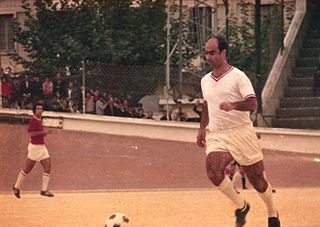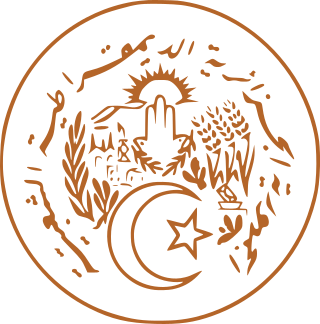
Algeria, officially the People's Democratic Republic of Algeria, is a country in the Maghreb region of North Africa. It is the largest country by total area in Africa, and by extension, the Arab world, and is bordered to the northeast by Tunisia; to the east by Libya; to the southeast by Niger; to the southwest by Mali, Mauritania, and Western Sahara; to the west by Morocco; and to the north by the Mediterranean Sea. The country has a semi-arid geography, with most of the population living in the fertile north and the Sahara dominating the geography of the south. Algeria covers an area of 2,381,741 square kilometres (919,595 sq mi), with a population of 44 million, and is the ninth-most populous country in Africa. The capital and largest city is Algiers, located in the far north, on the Mediterranean coast.

Algerian music is virtually synonymous with Raï among foreigners; the musical genre has achieved great popularity in France, Spain and other parts of Europe. For several centuries, Algerian music was dominated by styles inherited from Al-Andalus, eventually forming a unique North African twist on these poetic forms. Algerian music came to include suites called nuubaat. Later derivatives include rabaab and hawzii.

The Maghreb, also known as Northwest Africa, the Arab Maghreb, and historically as "theBarbary Coast", is the western part of North Africa and the Arab World. The region includes Algeria, Libya, Mauritania, Morocco and Tunisia. The Maghreb also includes the disputed territories of Western Sahara and the cities of Ceuta and Melilla. As of 2018, the region had a population of over 100 million people.

Andalusian classical music or Andalusi music is a genre of music originally developed in al-Andalus by the Muslim population of Andalusia and the Moors, it then spread and influenced many different styles across the Maghreb after the Expulsion of the Moriscos. It originated in the music of Al-Andalus between the 9th and 15th centuries. Some of its poems derive from famous authors such as Al-Shushtari, Ibn al-Khatib and Al-Mu'tamid ibn Abbad.
Aïssa Messaoudi, nom de guerreTayeb el-Afghani, was an Algerian Islamist. He fought in the Afghan War. Together with a fellow Afghan veteran, Abderrahmane Dahane, he launched an attack on the Guemmar barracks on November 27, 1991, before the start of the Algerian Civil War proper; this attack is sometimes considered to mark the beginning of the Armed Islamic Movement (MIA). He was arrested on January 28, 1992.

In Amenas is a town and commune in eastern Algeria, bordering with Libya. The town is located 30 kilometres (19 mi) west of the border. There is no border crossing in the area. The municipality had 7,385 inhabitants in 2008, up from 5.302 in 1998, with an annual growth rate of 3.4% According to the Algerian novelist Mouloud Mammeri the name is a Tuareg word which means "lieu des méharis" or "place of camel drivers."

Chabab Riadhi de Belouizdad S.s.p.a, known as Chabab Belouizdad or CR Belouizdad or simply CRB for short, is an Algerian association football club based in Algiers, Algeria, that plays in the Ligue Professionnelle 1, the top flight of Algerian football. The club has competed in the top division for a record 55 seasons.
The Salafist Group for Preaching and Combat, known by the French acronym GSPC, was an Algerian terrorist faction in the Algerian Civil War founded in 1998 by Hassan Hattab, a former regional commander of the Armed Islamic Group (GIA). After Hattab was ousted from the organization in 2003, the group officially pledged support for al-Qaeda, and in January 2007, the group officially changed its name to the "Al-Qaeda Organization in the Islamic Maghreb" (AQIM).

The insurgency in the Maghreb refers to the Islamist insurgency in the Maghreb and Sahel regions of North Africa that followed on from the Algerian Civil War. The Algerian militant group Salafist Group for Preaching and Combat (GSPC) allied itself with al-Qaeda to eventually become al-Qaeda in the Islamic Maghreb (AQIM). The Algerian and other Maghreb governments fighting the militants have worked with the United States and the United Kingdom since 2007, when Operation Enduring Freedom – Trans Sahara began. While the 2011 Arab Spring affected support for the insurgency, it also presented military opportunities for the jihadists. In 2012, AQIM and Islamist allies captured the northern half of Mali, until being fought back less than a year later following a French-led foreign intervention, which was succeeded by the Sahel-wide Operation Barkhane. In Libya, the Islamic State of Iraq and the Levant (ISIL) has been able to control some limited territory in the ongoing civil war since 2014, amid allegations of local collaboration between the rival AQIM and ISIL.

Hacène Lalmas was an Algerian footballer. He played as a midfielder and was nicknamed El Kebch . He scored 131 goals in Algerian championship (record).
Events from the year 2009 in Algeria
Amari Saifi, also known under his aliases Abou Haidara or Abderrazak le Para, is one of the leaders of the Islamist militia Salafist Group for Preaching and Combat (GSPC).

Al-Qaeda in the Islamic Maghreb, or AQIM, is an Islamist militant organization which aims to overthrow the Algerian government and institute an Islamic state. To that end, it is currently engaged in an anti-government campaign.

Elections to the National Assembly of France were held in France, including Algeria, on 17 June 1951. There were 30 seats for Algeria out of 625 at the National Assembly.

Abdelhamid Abou Zeid was an Algerian national and Islamist jihadi militant and smuggler who, in about 2010, became one of the top three military commanders of al-Qaeda in the Islamic Maghreb (AQIM), a Mali-based militant organization. He competed as the chief rival of Mokhtar Belmokhtar, an Algerian national who had become the major commander in AQIM and later head of his own group. Both gained wealth and power by kidnapping and ransoming European nationals. After taking control of Timbuktu in 2012, Abou Zeid established sharia law and destroyed Sufi shrines.
Émilie Busquant, born in Neuves-Maisons March 3, 1901 and died in Algiers October 1953, was a French feminist, anarcho-syndicalist and anti-colonial activist who was married to the Algerian nationalist leader Messali Hadj. She is best known for the role she played in the creation of the Algerian flag.

The Ministry of Health, Population and Hospital Reform (MSPRH) is the health ministry of Republic of Algeria. It is located in El Madania, a municipality of Algiers. The Ministry is responsible for public health facilities and population monitoring. The Minister is a member of the Council of Ministers of Algeria, which reports to the President of Algeria as part of the executive branch of the government.
Ali Yahia Abdennour was an Algerian politician, lawyer and human rights activist.

The Zawiyas in Algeria are religious buildings located in Algeria honoring the memory of patron saints and dedicated to Quranic and religious education. They are affiliated with Sufi Torouq brotherhoods under the supervision of the Ministry of Religious Affairs and Endowments in accordance with the precepts of the Algerian islamic reference.










